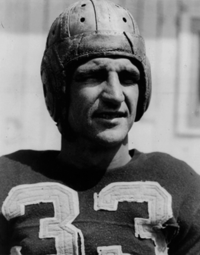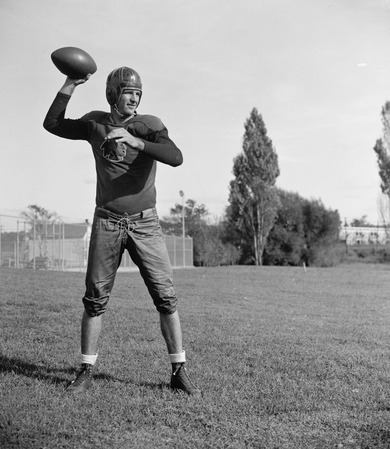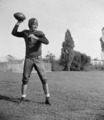Sammy Baugh facts for kids

Baugh in 1938
|
|||||||||||||||
| No. 33, 45 | |||||||||||||||
|---|---|---|---|---|---|---|---|---|---|---|---|---|---|---|---|
| Position: |
|
||||||||||||||
| Personal information | |||||||||||||||
| Born: | March 17, 1914 Temple, Texas |
||||||||||||||
| Died: | December 17, 2008 (aged 94) Rotan, Texas |
||||||||||||||
| Height: | 6 ft 2 in (1.88 m) | ||||||||||||||
| Weight: | 182 lb (83 kg) | ||||||||||||||
| Career information | |||||||||||||||
| High school: | Sweetwater (Sweetwater, Texas) |
||||||||||||||
| College: | TCU | ||||||||||||||
| NFL Draft: | 1937 / Round: 1 / Pick: 6 | ||||||||||||||
| Career history | |||||||||||||||
| As player: | |||||||||||||||
|
|||||||||||||||
| As coach: | |||||||||||||||
|
|||||||||||||||
| Career highlights and awards | |||||||||||||||
|
|||||||||||||||
| Career NFL statistics | |||||||||||||||
|
|||||||||||||||
| Player stats at PFR | |||||||||||||||
|
Pro Football Hall of Fame
|
|||||||||||||||
|
College Football Hall of Fame
|
|||||||||||||||
Samuel Adrian Baugh (born March 17, 1914 – died December 17, 2008) was a famous American football player and coach. He was best known as a quarterback, but he was also a great punter and defensive back. Sammy played college football at Texas Christian University (TCU), where he was named an All-American twice. Then, he played in the National Football League (NFL) for the Washington Redskins from 1937 to 1952. After playing, he coached for Hardin–Simmons University, the New York Titans, and the Houston Oilers.
Sammy Baugh led the Washington Redskins to win the NFL Championship in 1937 and 1942. He was named NFL Player of the Year in 1947 and 1948. In those years, he led the league in completions, attempts, completion percentage, and passing yards. In 1947, he also led in passing touchdowns and passer rating.
Baugh was amazing at passing the ball. He led the league in completion percentage a record eight times. He also led in passing yards four times and passer rating three times. But he was also very good at other things. He was a top punter and a strong defensive back. He led the league in yards per punt five times. In 1943, he led the league in punting yards and defensive interceptions with 11. His 51.4 yards per punt in 1940 is still an NFL record today.
Sammy Baugh was put into the Pro Football Hall of Fame in 1963. He was also chosen for the NFL 75th Anniversary All-Time Team in 1994 and the NFL 100th Anniversary All-Time Team in 2019.
Contents
Early Life of Sammy Baugh
Samuel Adrian Baugh was born on a farm near Temple, Texas. He was the second son of James and Lucy Baugh. His father worked for the Santa Fe Railroad. His parents later divorced, and his mother raised the three children. When Sammy was 16, his family moved to Sweetwater, Texas. He went to Sweetwater High School.
As the quarterback for his high school football team, the Sweetwater Mustangs, he practiced for hours. He would throw a football through a swinging car tire, often while running. But he spent even more time practicing his punting.
Sammy really wanted to be a professional baseball player. He almost got a scholarship to play at Washington State University. But about a month before he was supposed to start, he hurt his knee sliding into second base. So, the scholarship didn't happen.
College Football Career
Coach Dutch Meyer told Sammy he could play three sports at Texas Christian University. These sports were football, baseball, and basketball. While at TCU, Sammy threw 587 passes in three seasons. He scored 39 touchdowns. He was named an All-American in 1935 and 1936.
He also led TCU to two bowl game wins. They beat LSU 3–2 in the 1936 Sugar Bowl. They also beat Marquette 16-6 in the first Cotton Bowl Classic in 1937. Sammy was named the MVP of that game. In 1936, he finished fourth in the voting for the Heisman Trophy.
In his senior year, Redskins owner George Preston Marshall offered Sammy $4,000 to play for his team. Sammy wasn't sure about playing professional football at first. His college coach offered him a job, and he still thought about playing professional baseball. He finally agreed to the contract after the College All-Star Game. His team beat the Green Bay Packers 6–0 in that game.
College and Minor League Baseball
Sammy Baugh also played baseball at Texas Christian. He played third base. During his time as a baseball player, he got the nickname "Slingin' Sammy." A sportswriter in Texas gave him this name.
After college, Sammy signed with the St. Louis Cardinals. They sent him to the minor leagues. He played for the Columbus Red Birds in Columbus, Ohio, as a shortstop. Then he went to the Rochester, New York Red Wings. He didn't get much playing time there and wasn't happy. So, he decided to play professional football instead.
Professional Football Career
As expected, the Washington Redskins picked Sammy Baugh in the first round of the 1937 NFL Draft. He was the sixth player chosen overall. This was the same year the team moved from Boston. He signed a one-year contract with the Redskins for $8,000. This made him the highest-paid player on the team.
In his first season in 1937, Baugh played quarterback, defensive back, and punter. He set an NFL record with 91 completions in 218 attempts. He also threw for a league-high 1,127 yards. He led the Redskins to the NFL Championship game against the Chicago Bears. He threw for 335 yards and three touchdowns in the second half. Washington won 28–21. His 335 passing yards was a rookie playoff record until 2012.
The Redskins and Bears played in three championship games between 1940 and 1943. In the 1940 Championship game, the Bears won 73–0. This was the biggest win in NFL history. After the game, Baugh was asked what would have happened if the Redskins had scored a touchdown early. He joked, "What? The score would have been 73-7."
Sammy Baugh was at his best during World War II. In 1942, Baugh and the Redskins won their conference with a 10–1 record. The Bears were also very strong that year, going 11–0. In the 1942 Championship game, Baugh threw a touchdown pass. He also kept the Bears pinned back with strong punts, including an 85-yard kick. Washington won 14–6.
"I didn't know how much pro players were making, but I thought they were making pretty good money. So I asked Mr. Marshall for $8,000, and I finally got it. Later I felt like a robber when I found out what Cliff Battles and some of those other good players were making. I'll tell you what the highest-priced boy in Washington was getting the year before—not half as much as $8,000! Three of them—Cliff Battles, Turk Edwards and Wayne Millner—got peanuts, and all of 'em in the Hall of Fame now. If I had known what they were getting I'd have never asked for $8,000."
Many people think Baugh had the best single season ever by a pro football player in 1943. He led the league in pass completions, punting (45.9-yard average), and interceptions (11). In one game that season, he threw four touchdown passes and intercepted four passes. This was in a 42–20 win over Detroit. He was named an All-Pro tailback that year. The Redskins reached the championship game again but lost to the Bears 41–21. During the game, Baugh got a concussion while tackling Bears quarterback Sid Luckman and had to leave.
In the 1945 season, Baugh completed 128 of 182 passes. This was a 70.33 completion percentage, which was an NFL record then. It is still the fourth-best today. He threw 11 touchdown passes and only four interceptions. The Redskins won their conference again but lost 15–14 in the 1945 Championship game against the Cleveland Rams. The one-point difference was due to a safety early in the game.
In the first quarter, the Redskins had the ball at their own 5-yard line. Baugh dropped back into the end zone and threw to a receiver. But the ball hit the goal post, which was on the goal line back then. It bounced back to the ground in the end zone. This was ruled a safety, giving the Rams a 2–0 lead. This safety ended up being the winning margin. The team owner, George Preston Marshall, was so angry that he helped change the rule. Now, a forward pass that hits the goal posts is automatically incomplete. This is known as the "Baugh/Marshall Rule."
"The best, as far as I'm concerned. He could not only throw the ball, he could play defense, he could punt the football, he ran it when he had to. He and I roomed together, and he was a football man. He knew football, played it, and everybody had a lot of confidence in him."
One of Baugh's most famous games was on "Sammy Baugh Day" on November 23, 1947. The Washington D.C. Touchdown Club honored him at Griffith Stadium and gave him a car. Against the Chicago Cardinals, he passed for 355 yards and six touchdowns. That season, the Redskins finished 4–8. But Baugh had career highs in completions (210), attempts (354), yards (2,938), and touchdown passes (25). He led the league in all four areas.
Baugh played for five more years. He led the league in completion percentage for the sixth and seventh times in 1948 and 1949. He retired after the 1952 season. In his last game, a 27–21 win over Philadelphia, he played for a few minutes. He then left the field to a long standing ovation from the crowd. Baugh won many NFL passing titles. He was named first-team All-NFL four times. He completed 1,693 of 2,995 passes for 21,886 yards.
Sammy Baugh's NFL Records
When he retired, Sammy Baugh held 13 NFL records. These were for his play as a quarterback, punter, and defensive back. He is seen as one of the greatest football players of all time. He helped make Redskins fans so passionate. Michael Wilbon of The Washington Post said, "He brought not just victories but thrills and ignited Washington with a passion." He was the first to play quarterback in a modern way. He made the forward pass a powerful weapon, not just a last resort.
Two of his quarterback records still stand today. He has the most seasons leading the league in passing (six, tied with Steve Young). He also has the most seasons leading the league with the lowest interception percentage (five). He is fourth in highest single-season completion percentage (70.33%). He also led the league in yards gained four times and in completion percentage seven times.
As a punter, Baugh retired with the NFL record for highest punting average in a career (45.1 yards). He is still second all-time (Shane Lechler is first with 46.5 yards). He also has the best (51.4 in 1940) and fourth-best (48.7 in 1941) season averages. He led the league in punting from 1940 through 1943. As a defensive back, he was the first player to intercept four passes in a game. He is also the only player to lead the league in passing, punting, and interceptions in the same season.
It's hard to compare Baugh to modern players. The football in his time was rounder and fatter, making it harder to pass well. Also, pass-interference rules are much stricter now. This makes modern quarterbacks' statistics look higher.
Coaching Career
While playing for the Redskins, Baugh and teammate Wayne Millner were assistant coaches. They coached the Catholic University's Cardinals. They went with them to the 1940 Sun Bowl. Baugh left Washington, D.C. in 1952. He chose not to come back for Redskins team events, even when invited.
After his playing career, he became the head coach at Hardin–Simmons University. He had a record of 23 wins and 28 losses between 1955 and 1959.
Baugh was the first coach of the New York Titans of the American Football League in 1960 and 1961. His record was 14 wins and 14 losses. He was an assistant coach at the University of Tulsa in 1963. There, he coached All-American quarterback Jerry Rhome. In 1964, Baugh coached the AFL's Houston Oilers and had a record of 4 wins and 10 losses.
Acting Career
Sammy Baugh also tried acting. In 1941, he earned $6,400 for starring in a 12-week movie series. He played a dark-haired Texas Ranger named Tom King. The series was called King of the Texas Rangers and was made by Republic Studios. The episodes were shown in theaters as Saturday matinees. It also starred Duncan Renaldo, who later became famous as TV's Cisco Kid.
The actor Robert Duvall based his character Gus McCrae in the TV series Lonesome Dove on Baugh. He especially copied Baugh's arm movements. Duvall visited Baugh at his home in Texas in 1988.
Later Life and Death
After retiring from football, Baugh and his wife, Edmonia Smith, moved to their ranch. They had four boys and one girl. Edmonia passed away in 1990, after 52 years of marriage. She was his high school sweetheart. According to his son, Sammy enjoyed ranching much more than football. He said he liked the game, but if he could live his life again, he probably wouldn't play sports at all.
Sammy Baugh's health got worse after his wife died. In his last years, he lived in a nursing home in Jayton, Texas. This town was near his Double Mountain Ranch. His son David now owns the 20,000-acre ranch. It is still a cow-calf operation.
Sammy Baugh's Passing
The Associated Press reported on December 17, 2008, that Baugh had died. He had many health problems, including Alzheimer's disease. He passed away at Fisher County Hospital in Rotan, Texas. He is buried at Belvieu Cemetery in Rotan.
Honors and Tributes
Sammy Baugh was the last living member of the first group of 17 players inducted into the Pro Football Hall of Fame. The Redskins also honored him by retiring his jersey number, No. 33. This is one of only two numbers officially retired by the team.
The hip hop artist Jay-Z wore Baugh's 1947 Washington jersey in his 2002 music video for "Girls, Girls, Girls." This made the throwback jersey very popular and helped more people learn about Sammy Baugh.
- Additional Honors
- A street in his hometown of Rotan, Texas is named after him.
- Named to the NFL's 50th Anniversary Team (1969).
- Named to the NFL's 75th Anniversary Team (1994), included in Madden NFL 10.
- Ranked 36th greatest athlete of the 20th century by Burt Randolph Sugar (1995).
- Ranked 64th greatest athlete of the 20th century by ESPN (1999).
- Ranked 43rd greatest athlete of the 20th century by the Associated Press (1999).
- Ranked 3rd greatest NFL player of the 20th century by the Associated Press (1999).
- Ranked 11th greatest NFL player of the 20th century by The Sporting News (1999) (highest-ranking player for the Redskins).
- Named to the Scripps-Howard all-time college football team (1999).
- Ranked 14th greatest NFL player of all-time by NFL Network/NFL Films (2010).
- Ranked 4th greatest college football player by SPORT magazine (1999).
- Ranked 3rd greatest college football player by College Football News (2003).
- Ranked 7th greatest college football player by Brad Rawlins (2006).
- Ranked 5th greatest college football player by ESPN (2007).
- Named starting quarterback, defensive back and punter of the Cold, Hard Football Facts.com "All-Time 11" (2006).
- Named as the Most Versatile Player of all-time by the NFL Network (2007).
- His number (21) is retired at Sweetwater High School, his old school.
- A children's home in Jayton, Texas, was named in his honor.
- TCU's indoor practice building is named after him.
- Included as an All-Player Legend on Madden NFL 25 and Madden NFL 15 as a quarterback.
- The golf course at Western Texas College (http://sammybaughgolf.com) is named for him.
Images for kids
See also
 In Spanish: Sammy Baugh para niños
In Spanish: Sammy Baugh para niños




